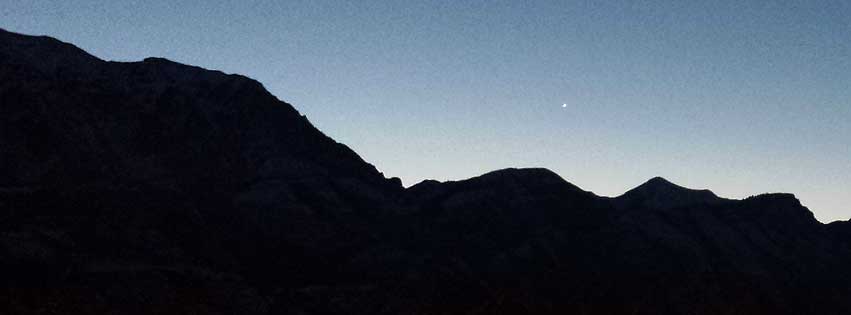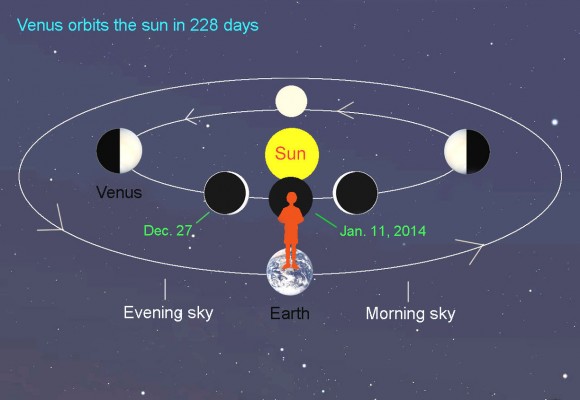Recently as I returned from an early-morning hike just at dawn, I looked to the east and saw a simple, but beautiful sight — a single bright star shining in the eastern sky, defying the increasing sunlight. I watched for a while until it lost the battle and faded from view.
Of course, it wasn't a star at all; it was the planet Venus, known in this phase of its orbit as "the morning star." I was thrilled to notice it this week in its morning phase, because of the symbolism it evokes. It will be visible for several more months in the morning sky, then will "disappear" behind the sun in late summer, to reappear at the end of the year as "the evening star."
Because Venus is closer to the sun than Earth, and has a 225-day "year" (orbit around the sun), it sometimes appears in the morning and sometimes in the evening. When it's on the "trailing" side of the sun, it appears in the evening sky coming into view as the sun sets — the "Evening Star." When its orbit takes it to the other side, it "leads" the sun in the morning, appearing in the sky for an hour or two before dawn — the "Morning Star." Ancient observers thought these two manifestations were different celestial bodies; the Greeks called the morning star Phosphoros, “the bringer of light,” and the evening star Hesperos, “the star of the evening.”
Because of its proximity to the Earth and to the sun, Venus is by far the brightest object in the nighttime sky (except for the moon). Its brightness and unusual movements have attracted the attention of sky-watchers as long as history records, and the symbol of "the morning star" in art, architecture, and literature has been a lasting one.
The original Nauvoo temple bore symbolism using stars, identified as "the star of the morning" — recreated in the current Nauvoo temple. (It's interesting that before the area was known as Nauvoo or Commerce, it was known by local residents as Venus...)
Both the stained-glass stars and the carved stone ones are pointed downward — symbolic of light being given to the earth from above. The elongated center point on the stone star emphasizes the manifestation from above. (Note that the theory of some critics that the "inverted pentagram" is a Satanic symbol is easily refuted; see, for example, this essay on the FAIR website.)
I loved that blue and red star so much, that a number of years ago I commissioned an art work representation from a talented young LDS artist named Lisa DeLong who has studied geometric representations in Islamic art. She came up with this beautiful interpretation, which hangs in our home:
One of the most tender and moving descriptions of the Savior is this one, near the end of the Revelation of John:
I Jesus have sent mine angel to testify unto you these things in the churches. I am the root and the offspring of David, and the bright and morning star. (Rev 22:16)
The "bright and morning star" ultimately is the Savior. The star, both in the sky and in its artistic representations, should remind us of Him.
Is it any wonder how critical a star is in our traditional representations of the Nativity? Though we don't usually see a 5-pointed star, we do see the elongated downward-reaching point, a manifestation of the love of the Father and a guide to us of where to seek True Light. That downward ray seems to remind us of a divine eagerness to give the most precious gift of Light to a world the lies in darkness.
The heavens reaching down to earth evoke a feeling of another tender and powerful concept from the scriptural record — "condescension" (see 1 Ne 11). The Divine come down to be as man, that He might lift man back to the heavens.
The Evening Star is the first to appear at night; the Morning Star is the last that is visible in the morning. First and Last, Alpha and Omega, the Beginning and the End.
I love this testimony of Peter:
For we have not followed cunningly devised fables, when we made known unto you the power and coming of our Lord Jesus Christ, but were eyewitnesses of his majesty. …The morning star will become a day star as the Lord's presence first arises, then abides in our our hearts.
We have also a more sure word of prophecy; whereunto ye do well that ye take heed, as unto a light that shineth in a dark place, until the day dawn, and the day star arise in your hearts. (2 Peter 1:16, 19)
Well might we rejoice with Alma:
...the earth, and all things that are upon the face of it, yea, and its motion, yea, and also all the planets which move in their regular form do witness that there is a Supreme Creator. (Alma 30:44)
And that there is a Divine Redeemer.





1 comment:
Wonderful symbolism. Thanks for putting it all together. There were some connections I hadn't made here. Your description of "the heavens reaching down to earth" reminded me of a description of Christ's cross that I recently ran across in a Christian publication: the upright post represents man reaching up to God, and the cross bar represents God reaching out to man.
Post a Comment